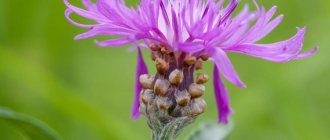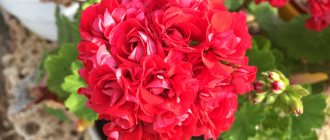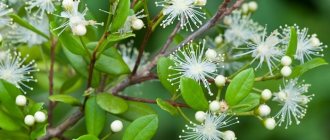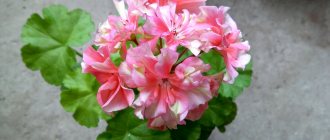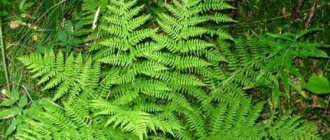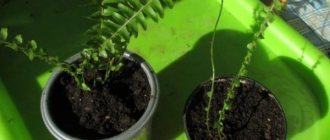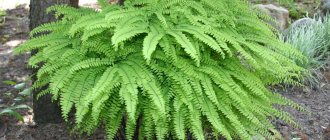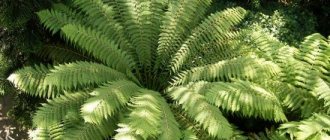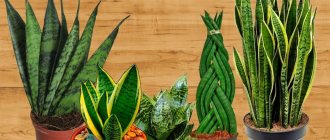Common ostrich (Matteuccia struthiopteris)
Of all the ferns grown in gardens, ostrich is the most common. It is grown in shady gardens, along the banks of ornamental ponds, in the crown of trees or in groups on the lawn. This is not a very convenient plant for flower beds, because... It can grow strongly to the sides and crowd out neighboring plants. Hostas and dicentras look good against the background of ostrich birds.
The ostrich leaves wintering early, having several leathery brown sporophylls - spore-bearing fronds. It is in the spring that they unfold, spores spill out and further die off. They resemble an ostrich feather in shape and give their name to this genus of ferns. They are replaced by sterile (non-spore-bearing) fronds, which initially look like snail-shaped curls; in Japan they are called “kogomi” (curls, curls). As they grow, they unfurl into magnificent feathery leaves arranged in a luxurious funnel-shaped rosette. In August, a new ring of spore-bearing fronds forms in the center of the rosette, and the sterile ones die off for the winter.
Ostrich sporophylls are often used for winter bouquets.
Common ostrich is a useful plant. Its rhizomes and fronds are raw materials for medicinal use. But this side of the issue requires a separate story.
It is impossible not to mention that the common ostrich is also an edible plant. Young rachis up to 20 cm long can be cooked fresh or prepared in a variety of ways - frozen, dried, salted, pickled. Ostrich is a delicacy plant in Far Eastern and Korean cuisine. The food use of this plant has been known since the 18th century. For Canadian Indians, ostrich was a common spring food; they fried it on stones and branches. Their example was then followed by French and English colonists. And in Norway it was used in brewing.
Common ostrich (Matteuccia struthiopteris)
Description: varieties and varieties of ostrich
Ostrich is a fern belonging to the Onocleaceae family. Its native climate is temperate. The culture got its name because of the structure of the leaves, which is why it is sometimes called ostrich feather, as well as black fern or German ostrich fern. Characteristics:
- height - up to 2 m;
- leaf arrangement is vertical;
- form - feathery fern;
- taller leaves form a funnel, in the middle of which there are low leaves with spores;
- color - emerald green for large leaf blades and brown for spore-bearing ones;
Ostrich leaves
- the size of the main leaves is 1.5 m in length and about 30-40 cm in width;
- The root system is vertical, powerful and long; underground creeping shoots extend from the roots.
Attention! Ferns of any variety oppress all neighboring plants.
At the beginning of the growing season, all the fronds of the plant are tightly curled. Then they gradually unfold and form the very funnel for which this fern is valued. The ostrich looks most attractive in June, as can be seen in the photo. Large leaves die off in the fall, and overwintered fronds with spores unfold and shed seeds in the spring.
There is no division into varieties as such for the common ostrich. Some botanists identify the Pennsylvania variety, but only a specialist can distinguish it. The common fern has a relative - the oriental fern. It differs in the shape and size of the feathers of the first row. The root system of its varieties is less aggressive, but this fern is more difficult to care for and reproduce.
German ostrich (Matteuccia struthiopteris (L.) Tod., S. filicastrum germanica All.)
In crop production
Ferns have found quite wide application in modern landscape design. They are planted in shaded areas of rock gardens, as well as along the edges of artificial reservoirs to decorate their surface. The plant is very winter-hardy and undemanding in care.
In nature, the German ostrich can grow up to two meters in height, and in garden plots - up to about 1 meter. The plant decorates the site at any time of the year. In the spring, the first snail leaves appear, which subsequently unfold and become beautiful leaves. In the second half of summer, spore-bearing leaves appear, which are located in the middle of the bush, slightly lower than the others and change color to brown after the spores ripen. At this time, they are usually cut as dried flowers for bouquets, since, unlike green leaves, they retain their shape, do not fall off even after frost, and last all winter.
The ostrich feels best in shaded areas. The soil should not be very heavy and, if possible, kept moist. Ostrich grows especially well near a pond. The fern can grow in the sun, but this has a bad effect on the color and height of the plant. When planting ostrich in groups, the distance between the bushes should be about 50–60 cm.
In spring, ostrich birds are covered when it gets cold, as young shoots may suffer from return frosts. If the leaves are damaged by frost, the ostrich does not die; new shoots simply grow later. In autumn, the bushes can simply be mulched.
Ostrich grows quickly and can oppress neighboring plants. If small bushes appear around the main bush, they should be replanted in the spring, after wintering. You can also propagate ostrich by rhizomes, cutting them into pieces with several buds. The plant is quite aggressive, so replanting will have to be done every 3-4 years and it is better to do this in the spring, before the leaves grow.
Ostrich can also be propagated using spores. Spores are sown in disinfected bedding peat, covered with glass and regularly moistened. Spores germinate in 2–5 weeks. Then the young ferns need to be picked into boxes with a mixture of equal parts of peat chips, heather soil and sand. After this, the established ferns are planted in pots for growing and after two years they are planted in place. Ostrich plants grown from spores in this way develop into more powerful and resistant plants.
Ferns look very good in groups. They are usually planted on the north side of buildings. Hostas look good next to ferns. Primroses also grow well with ferns. In the first half of summer, while the ferns are growing, the primroses will have time to bloom and the ostrich will cover the empty space. If there is a pond on the site, you can decorate its shore with a combination of ostriches, irises and sedges.
Common ostrich: planting a plant
Seedlings 2-3 years old are suitable for planting in open ground. Choose a shaded place on the site for them. In the sun the ostrich will grow, but will not be large. Flower growers advise planting the plant in groups of 5-7 pieces.
The planting pattern is as close to natural as possible. For example, irregular triangles. At the same time, keep a distance of 0.3-1 m. The advantage of this method is that in a couple of years the fern will independently increase its number vegetatively. All you have to do is manage to remove unnecessary plants, and from all the rest, form a green decoration for the site.
Choose a shaded place on the site for the ostrich
Plant care, fertilizer and feeding
Ostrich is a strong and viable plant. Therefore, growing it is a pleasure. First of all, neighboring garden, vegetable or ornamental crops, if any, need care and protection. Gardeners use artificial barriers. For example, a wide plastic tape dug around the perimeter of the planned site. For planting in a flowerbed, you can use a large bucket without a bottom, with which the fern is buried.
Attention! Growing an ostrich in one place without problems is possible for 6-7 years. Then the plant can be replanted. The procedure is performed in the spring. There is no need to remove the entire plant - it is enough to take only part of the rhizome with a bud. In a new location, the plant requires abundant watering to adapt.
Other aspects of caring for the common ostrich in open ground:
- Control humidity. During drought, the plant should be sprayed.
- For the winter, the ostrich needs to be covered only if prolonged frosts of -10 °C or stronger are expected in your region.
- Fern does not tolerate heat from +25 °C.
- Watering is moderate. If there is no rain for a long time, increase the dose of water.
This fern does not need fertilizer. But still, flower growers sometimes use them. Any organic and mineral mixtures will do. Apply fertilizers approximately once a month during the first year of the plant’s life, at your discretion.
Ostrich in landscape design
Ostrich fern is used in the design of park areas and garden plots. Most often it is planted under the crowns of trees and other shady corners of the garden. This plant can successfully hide the bare roots of shrubs or faded bulbous flowers that spoil the appearance. In a flowerbed, a fern will be an excellent backdrop for tall plants. Well suited for decorating boulders, alpine slides, trees and the edge of a pond.
Garden fern - planting and care
The lush forms of the plant are ideal for decorating a garden in the Naturgarden or eco-garden style - a direction in which plants and landscape elements are arranged in natural disorder.
Important! Since Ostrich actively grows in all directions, it is not recommended to plant it next to paths.
A good example of using a plant in the landscape
Common ostrich: plant propagation
Like other ferns, the ostrich fern is strong in independent reproduction by spores. Collected spore capsules are a fairly effective and at the same time troublesome method. The best time to collect spores is late summer-early autumn. They are suitable both for storage in a dry place and for immediate planting for propagation. In any case, peat bedding is suitable for seedlings. Disinfect it first.
Ostrich grows well on its own
Deepen the spores into the substrate, then water and cover with glass or film. Among the care measures, the crops only need periodic moistening. Sprouts will appear in 25-40 days. Transplant them immediately into special soil for ferns, which can be purchased at the store. Further care and cultivation of the plant consists of maintaining a high level of humidity and, if necessary, replanting it in a larger pot. In this mode, young plants will live for several years before being planted in open ground.
An alternative to spores is vegetative propagation by root shoots. To do this, look for them in the top layer of soil. Plan the work for early spring or August. The shoot should have 2-3 buds:
- Cut the shoots to about 10 cm in length.
- Plant them in open ground at intervals of at least 50 cm.
Attention! At the first stage of development, fertilizers are not needed for ostriches planted in any way.
Use in folk medicine
In official medicine , ostrich is not used, but in herbal medicine it has been known and used for a long time:
- A decoction of the roots treats cancer, painful and heavy menstruation, and fever.
- A decoction of the above-ground part reduces swelling and inflammation in hemorrhoids and stops bleeding from the rectum.
- An alcoholic tincture of rhizomes is used to treat a suffocating cough. Bronchitis, whooping cough, and cough are also treated with fig fruits boiled in milk.
- Compresses with tincture on the rhizomes relieve inflammation of the sciatic nerve.
- Alcohol tincture is used to treat intestinal upset, diarrhea, inflammation of the middle ear, the consequences of nervous overexcitation, and is taken as a general strengthening and tonic.
- Crushed dried leaves are added daily to salad to improve the condition of radiation sickness.
- The powder of crushed leaves expels worms, even such dangerous ones as bovine tapeworm and tapeworm.
- The crushed root is mixed with sour milk and applied to dilated veins and venous nodes for varicose veins.
- Dry spores are sprinkled on open wounds, burns, abrasions, wet scabs, and eczema.
- Steamed leaves are applied to inflamed joints. Joint pain, rheumatism, and arthritis are treated with herbal poultices.
- Fern petioles salted for the winter help maintain a healthy immune system, get rid of stress, increase stamina and improve overall well-being, and compensate for the lack of silicon in the body. High levels of silicon and silicic acid were also found in the inconspicuous knotweed.
Herbalists and doctors do not recommend self-medication, especially when it comes to serious diseases. The dosage , course and form of administration are prescribed individually after a medical examination.
Ostrich diseases and pests
The common ostrich can take a liking to the Tarfin marsupial mushroom. This parasitic organism causes leaf spot. In addition, it sometimes touches neighboring ornamental and fruit trees. Affected tissues should be cut off and burned, and the plant should be sprayed with a fungicide. Spring treatment of plantings with copper sulfate or Bordeaux mixture helps as a preventive measure.
Take preventive measures against fungal diseases
Useful properties of ostrich
Ferns are considered record holders for their ability to accumulate silicon, and ostrich is no exception. Silicon is involved in the absorption of many mineral salts and vitamins, prevents osteoporosis, stimulates the immune system, improves the condition of the skin and nails, strengthens connective tissue, cartilage, tendons and blood vessels.
Once in the body, it “glues” the cells of microorganisms, bacteria, influenza viruses, hepatitis, candidiasis to its molecules and neutralizes them. Therefore, a sufficient amount of silicon in the body is the key to preventing stroke and heart attack, diabetes, cancer and many other diseases. Ostrich has the effect :
- astringent;
- antitussive;
- antispasmodic;
- painkillers;
- sedative;
- anticonvulsant;
- antiepileptic;
- anthelmintic;
- anti-inflammatory;
- antiseptic.
Ostrich: combination with other plants
A group planting of ostrich birds is a beautiful combination in itself. When choosing other companions, keep in mind that the fern growing season begins late. In the design of plots, the camouflage properties of ostrich grass are used to hide early fading crops: crocuses, scillas, etc.
Fern in company with moss, driftwood and stumps will create a forest composition on the site. This photo-atmospheric installation will be complemented by saxifrage, primrose, loosestrife or creeping tenacious. The combination of ostrich with leopard, daylilies, decorative varieties of cereals and irises looks interesting.
